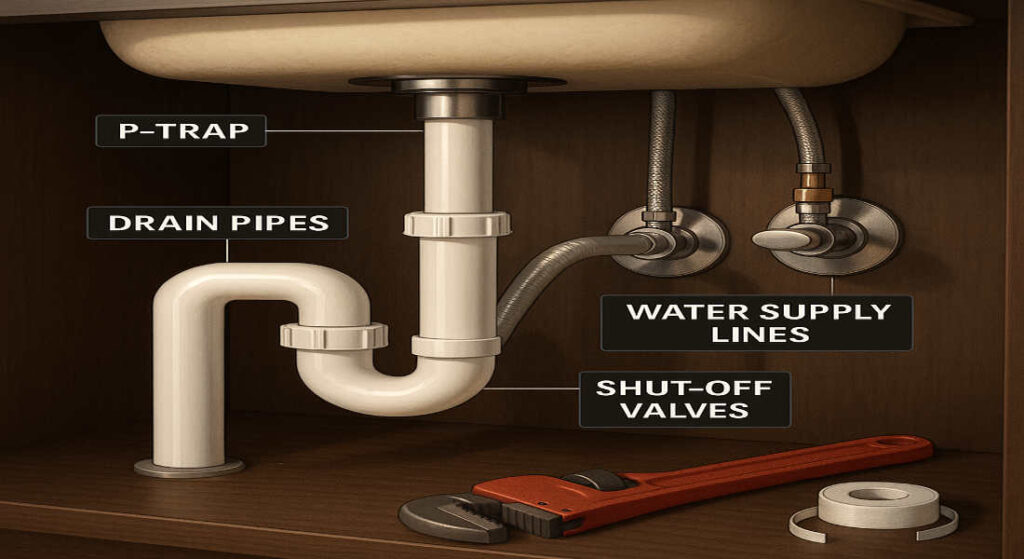If you’ve ever faced a leak or clog under your sink, you know how frustrating it can be. The good news? Understanding the basics of under-sink plumbing and taking the proper steps can save you time, money, and stress.
Why Under-Sink Plumbing Matters for Every Homeowner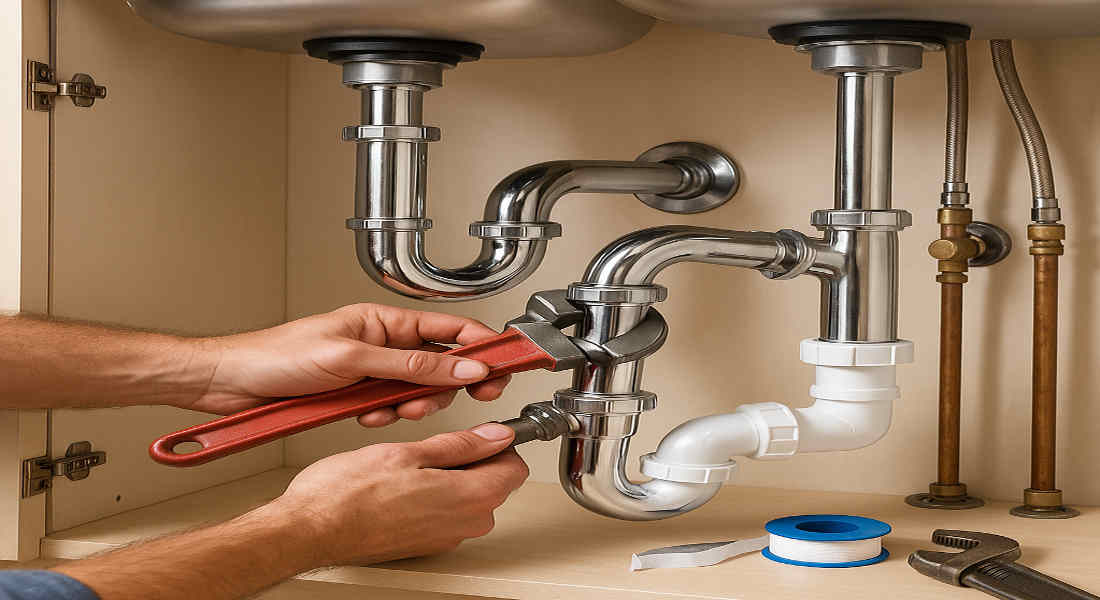
Your sink is one of the most used fixtures in your home—whether in the kitchen or bathroom. It handles everything from washing dishes to brushing teeth, so ensuring the plumbing underneath works properly is critical. A small leak or clog can quickly escalate into a bigger issue, causing water damage, mold, or unpleasant odors.
Understanding Under-Sink Plumbing Basics
Before you can fix your plumbing, it’s essential to understand how it works. Let’s break it down.
What Is Under-Sink Plumbing?
Under-sink plumbing consists of several key components, each playing a vital role in water flow and drainage:
- P-Trap: The curved pipe that traps water and prevents sewer gases from entering your home.
- Supply Lines: Pipes that deliver hot and cold water to your faucet.
- Shut-Off Valves: Controls to stop water flow during repairs.
- Drain Pipes: Carries wastewater away from the sink.
These parts are typically made of materials like PVC, ABS, or metal, chosen for their durability and resistance to water damage.
Common Types of Under-Sink Setups
Not all under-sink plumbing is the same. Here are the most common configurations:
Single vs. Double Sink
- Single Sink: Has one drainpipe and P-trap for simpler maintenance.
- Double Sink: Often found in kitchens, with two drains that merge into one pipe.
Bathroom vs. Kitchen Plumbing
- Bathroom setups are simpler, focusing on water supply and drainage.
- Kitchen sinks may include garbage disposals or dishwasher connections, which add complexity.
How Under-Sink Plumbing Works
Here’s a simplified breakdown of the process:
- Water flows into the faucet through supply lines.
- Wastewater exits through the drain pipes.
- The P-trap holds water to block sewer gases.
- The system relies on proper venting to maintain pressure and prevent clogs.
If any part of this system is improperly installed or defective, it can lead to issues such as leaks, clogs, or unpleasant odors.
Tools & Materials Needed for Under-Sink Repairs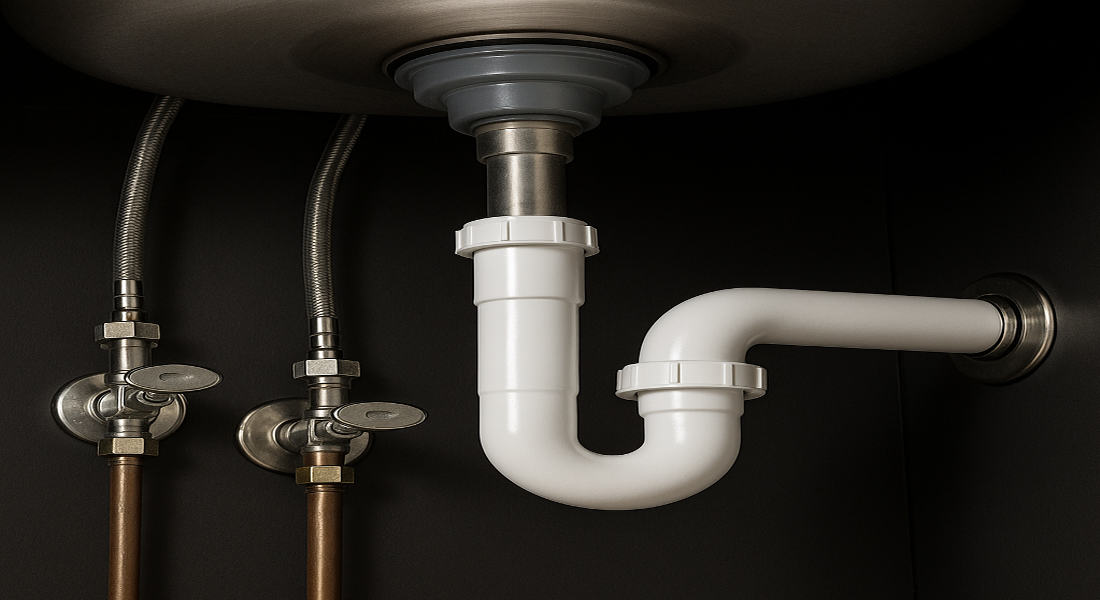
Before starting a repair, gather the right tools and materials. Having them on hand will make the process smoother.
You may also read (what is the worth of a home plumbing company).
Essential Tools
Here’s a list of must-have tools:
- Adjustable Wrench: For tightening or loosening connections.
- Pliers: Useful for gripping pipes and small parts.
- Pipe Cutter: Cuts pipes cleanly when replacements are needed.
- Plumber’s Tape: Seals threaded pipe joints to prevent leaks.
- Bucket: Catches water when disassembling pipes.
Pro Tip: Invest in specialty tools, such as a basin wrench or plumber’s snake, for tougher repairs.
Replacement Parts & Materials
When repairing under-sink plumbing, you may need to replace worn-out components such as:
- Pipes: Choose the right material (PVC, ABS, or metal).
- P-Trap: Replace cracked or corroded traps.
- Washers and Gaskets: Seal connections tightly.
- Plumber’s Putty: Seals gaps around fixtures.
Safety Precautions
Always prioritize safety:
- Turn Off the Water Supply: This prevents flooding during repairs.
- Protect Cabinet Floors: Use towels or plastic sheets to catch spills and avoid damage.
- Wear Gloves and Eye Protection: These shield you from sharp edges or chemicals.
Diagnosing Common Under-Sink Plumbing Problems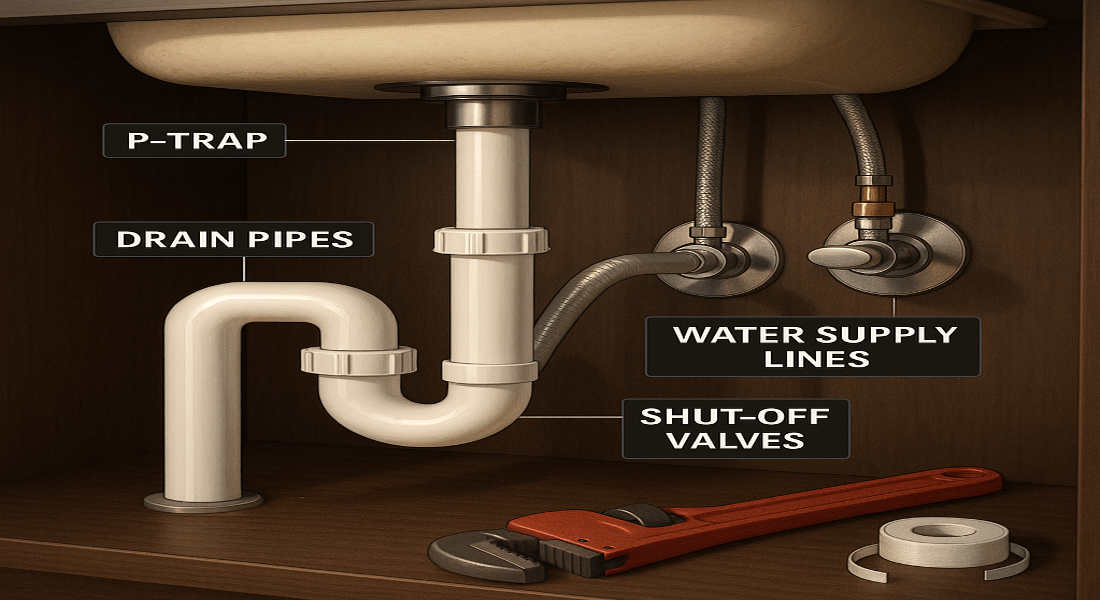
Let’s address the most common issues homeowners encounter and how to recognize them.
Leaks
Leaks are the most common under-sink issue. Here’s how to pinpoint the source:
- Supply Line Leaks: Look for dripping around the shut-off valve.
- P-Trap Leaks: Check for cracks or loose slip nuts.
- Drain Pipe Leaks: Water pooling under the sink is a telltale sign.
Clogs and Slow Drains
A clogged drain slows water flow and can create unpleasant backups. Typical causes include:
- Kitchen Sinks: Food scraps, grease, and soap scum.
- Bathroom Sinks: Hair, toothpaste, and dirt.
You may also read (the truth about eating decorative house pumpkins).
Signs of a clog include standing water or gurgling noises.
Low Water Pressure
If your faucet’s water pressure has decreased, it could be due to:
- Aerator Blockage: Mineral buildup in the faucet head.
- Supply Line Obstructions: Corrosion or debris restricting water flow.
Unpleasant Odors
Bad smells under your sink often indicate:
- Sewer Gas: A dry P-trap no longer blocks odors.
- Hidden Mold or Mildew: Caused by unnoticed leaks.
Step-by-Step Guide: How to Fix House Plumbing Under Sink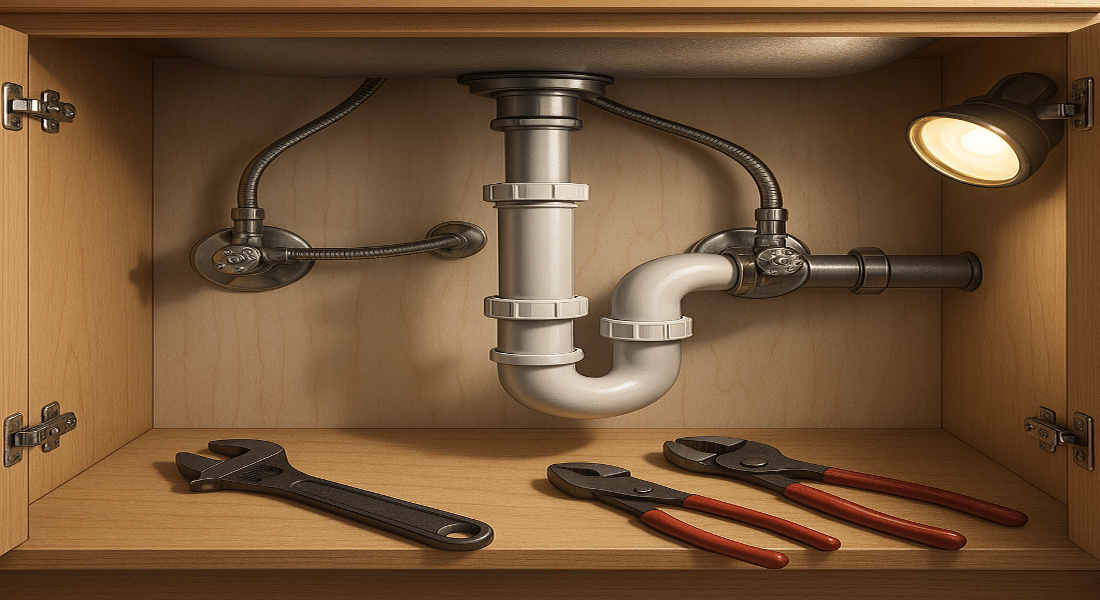
Now that you’ve identified the problem, let’s fix it!
Preparing for the Repair
- Turn Off the Water: Use the shut-off valves.
- Empty the Cabinet: Remove items and place a bucket under the pipes to catch any spills that may occur.
- Take Photos: Snap pictures of the plumbing setup for reference.
Fixing a Leaky Pipe
- Locate the leak’s exact spot.
- Tighten loose slip nuts or replace faulty washers.
- For cracked pipes, cut out the damaged section and install a replacement using a plumber’s tape.
Clearing a Clogged Drain
- Remove the pop-up stopper and clean it.
- Detach the P-trap and empty its contents.
- Use a plumber’s snake to clear any deeper clogs.
Restoring Water Pressure
- Unscrew the faucet aerator and soak it in vinegar to dissolve mineral buildup.
- Check and clean supply lines if the problem persists.
Reassembling and Testing
- Reattach all components, ensuring they are securely connected.
- Turn the water back on and check for leaks.
Preventative Maintenance Tips for Under-Sink Plumbing
Regular upkeep can save you from costly repairs.
Regular Inspections
Inspect your plumbing monthly for:
- Moisture or puddles under the sink.
- Corrosion or wear on pipes.
- Loose fittings or valves.
Cleaning and Care
- Use natural drain cleaners, such as baking soda and vinegar, on a monthly basis.
- Keep the cabinet dry and well-organized to prevent mold growth.
Upgrading Components
Consider replacing older parts with modern, durable options like:
- PVC Pipes: Lightweight and corrosion-resistant.
- Ball Valves: Easier to operate than traditional multi-turn valves.
When to Call a Professional Plumber
Some situations require expert help:
- Persistent Leaks: If you’ve tried DIY fixes without success.
- Recurring Clogs: This could indicate a larger issue in the main line.
- Water Damage: Visible mold or warped wood signals a long-term leak.
Troubleshooting Quick Reference Guide
Problem Cause Solution
Leak Loose connections, cracked pipes Tighten fittings, replace pipes
Clog Debris buildup Clean P-trap; use a plumber’s snake
Low Water Pressure Blocked aerator or supply lines Clean the aerator, check for obstructions
Foul Odors Dry P-trap, hidden leaks Refill P-trap, inspect for mold/mildew
You may also read (rerouting house plumbing essential tips and techniques).
